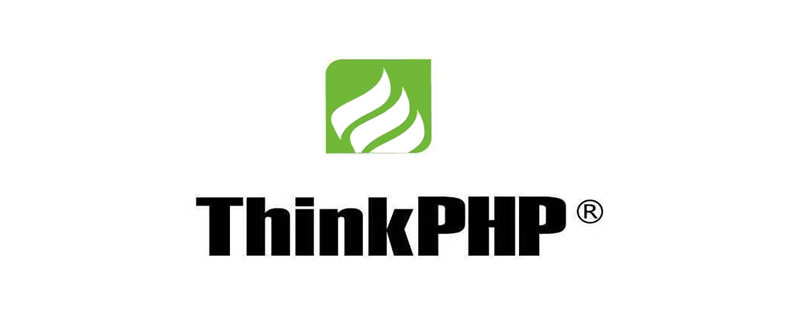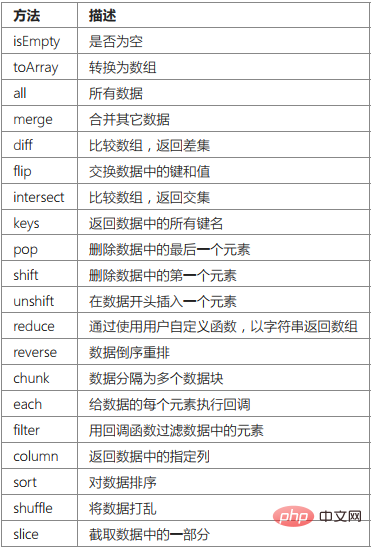 PHP Framework
PHP Framework
 ThinkPHP
ThinkPHP
 ThinkPHP database operations stored procedures, data sets, distributed databases
ThinkPHP database operations stored procedures, data sets, distributed databases
ThinkPHP database operations stored procedures, data sets, distributed databases
The following tutorial column will introduce you to the stored procedures, data sets, and distributed databases of ThinkPHP database operations. I hope it will be helpful to friends in need!

5.0 supports stored procedures, if we define A database stored procedure sp_query can be called in the following way: $result = Db::query('call sp_query(8)');
$result = Db::query('call sp_query(?)',[8]);
// 或者命名绑定$result = Db::query('call sp_query(:id)',['id'=>8]);Dataset
The query result of the database is also the data set. Under the default configuration, the type of the data set is a two-dimensional array. We can configure it into a data set. class, you can support more object-based operations on the data set. You need to use the data set class function. You can configure the resultset_type parameter of the database as follows: return [ // 数据库类型
'type' => 'mysql', // 数据库连接DSN配置
'dsn' => '', // 服务器地址
'hostname' => '127.0.0.1', // 数据库名
'database' => 'thinkphp', // 数据库用户名
'username' => 'root', // 数据库密码
'password' => '', // 数据库连接端口
'hostport' => '', // 数据库连接参数
'params' => [], // 数据库编码默认采用utf8
'charset' => 'utf8', // 数据库表前缀
'prefix' => 'think_', // 数据集返回类型
'resultset_type' => 'collection',];
// 获取数据集
$users = Db::name('user')->select();
// 直接操作第一个元素
$item = $users[0];
// 获取数据集记录数
$count = count($users);
// 遍历数据集
foreach($users as $user){ echo $user['name']; echo $user['id'];
}$users = Db::name('user')->select();if($users->isEmpty()){ echo '数据集为空';
}The Collection class contains the following main methods:
If the query of only individual data needs to return the data set object , you can useDb::name('user') ->fetchClass('\think\Collection') ->select(); Distributed database
Distributed database##ThinkPHP has built-in support for distributed databases, including master-slave The read and write separation of the traditional database, but the distributed database must be the same database type. Configuring database.deploy to 1 can use distributed database support. If a distributed database is used, the way to define database configuration information is as follows:
//分布式数据库配置定义 return [ // 启用分布式数据库 'deploy' => 1, // 数据库类型 'type' => 'mysql', // 服务器地址 'hostname' => '192.168.1.1,192.168.1.2', // 数据库名 'database' => 'demo', // 数据库用户名 'username' => 'root', // 数据库密码 'password' => '', // 数据库连接端口 'hostport' => '',]
'hostport'=>'3306,3306'
'hostport'=>'3306'
'username'=>'user1', 'password'=>'pwd1',
'username'=>'user1,user1', 'password'=>'pwd1,pwd1',
'rw_separate' => true,
If the slave database connection error occurs, it will automatically switch to the master database connection.
If you call the CURD operation of the model, the system will automatically determine whether the currently executed method is a read operation or a write operation. If you are using native SQL, you need to pay attention to the system's default rules:Write operations must use the model's execute method, and read operations must use the model's query method
, otherwise master-slave reading and writing chaos will occur.Note: The data synchronization work of the master-slave database is not implemented in the framework, and the database needs to consider its own synchronization or replication mechanism.
The above is the detailed content of ThinkPHP database operations stored procedures, data sets, distributed databases. For more information, please follow other related articles on the PHP Chinese website!

Hot AI Tools

Undresser.AI Undress
AI-powered app for creating realistic nude photos

AI Clothes Remover
Online AI tool for removing clothes from photos.

Undress AI Tool
Undress images for free

Clothoff.io
AI clothes remover

AI Hentai Generator
Generate AI Hentai for free.

Hot Article

Hot Tools

Notepad++7.3.1
Easy-to-use and free code editor

SublimeText3 Chinese version
Chinese version, very easy to use

Zend Studio 13.0.1
Powerful PHP integrated development environment

Dreamweaver CS6
Visual web development tools

SublimeText3 Mac version
God-level code editing software (SublimeText3)

Hot Topics
 1371
1371
 52
52
 How to run thinkphp project
Apr 09, 2024 pm 05:33 PM
How to run thinkphp project
Apr 09, 2024 pm 05:33 PM
To run the ThinkPHP project, you need to: install Composer; use Composer to create the project; enter the project directory and execute php bin/console serve; visit http://localhost:8000 to view the welcome page.
 There are several versions of thinkphp
Apr 09, 2024 pm 06:09 PM
There are several versions of thinkphp
Apr 09, 2024 pm 06:09 PM
ThinkPHP has multiple versions designed for different PHP versions. Major versions include 3.2, 5.0, 5.1, and 6.0, while minor versions are used to fix bugs and provide new features. The latest stable version is ThinkPHP 6.0.16. When choosing a version, consider the PHP version, feature requirements, and community support. It is recommended to use the latest stable version for best performance and support.
 How to run thinkphp
Apr 09, 2024 pm 05:39 PM
How to run thinkphp
Apr 09, 2024 pm 05:39 PM
Steps to run ThinkPHP Framework locally: Download and unzip ThinkPHP Framework to a local directory. Create a virtual host (optional) pointing to the ThinkPHP root directory. Configure database connection parameters. Start the web server. Initialize the ThinkPHP application. Access the ThinkPHP application URL and run it.
 Which one is better, laravel or thinkphp?
Apr 09, 2024 pm 03:18 PM
Which one is better, laravel or thinkphp?
Apr 09, 2024 pm 03:18 PM
Performance comparison of Laravel and ThinkPHP frameworks: ThinkPHP generally performs better than Laravel, focusing on optimization and caching. Laravel performs well, but for complex applications, ThinkPHP may be a better fit.
 How to install thinkphp
Apr 09, 2024 pm 05:42 PM
How to install thinkphp
Apr 09, 2024 pm 05:42 PM
ThinkPHP installation steps: Prepare PHP, Composer, and MySQL environments. Create projects using Composer. Install the ThinkPHP framework and dependencies. Configure database connection. Generate application code. Launch the application and visit http://localhost:8000.
 Development suggestions: How to use the ThinkPHP framework to implement asynchronous tasks
Nov 22, 2023 pm 12:01 PM
Development suggestions: How to use the ThinkPHP framework to implement asynchronous tasks
Nov 22, 2023 pm 12:01 PM
"Development Suggestions: How to Use the ThinkPHP Framework to Implement Asynchronous Tasks" With the rapid development of Internet technology, Web applications have increasingly higher requirements for handling a large number of concurrent requests and complex business logic. In order to improve system performance and user experience, developers often consider using asynchronous tasks to perform some time-consuming operations, such as sending emails, processing file uploads, generating reports, etc. In the field of PHP, the ThinkPHP framework, as a popular development framework, provides some convenient ways to implement asynchronous tasks.
 How is the performance of thinkphp?
Apr 09, 2024 pm 05:24 PM
How is the performance of thinkphp?
Apr 09, 2024 pm 05:24 PM
ThinkPHP is a high-performance PHP framework with advantages such as caching mechanism, code optimization, parallel processing and database optimization. Official performance tests show that it can handle more than 10,000 requests per second and is widely used in large-scale websites and enterprise systems such as JD.com and Ctrip in actual applications.
 RPC service based on ThinkPHP6 and Swoole to implement file transfer function
Oct 12, 2023 pm 12:06 PM
RPC service based on ThinkPHP6 and Swoole to implement file transfer function
Oct 12, 2023 pm 12:06 PM
RPC service based on ThinkPHP6 and Swoole implements file transfer function Introduction: With the development of the Internet, file transfer has become more and more important in our daily work. In order to improve the efficiency and security of file transfer, this article will introduce the specific implementation method of the RPC service based on ThinkPHP6 and Swoole to implement the file transfer function. We will use ThinkPHP6 as the web framework and utilize Swoole's RPC function to achieve cross-server file transfer. 1. Environmental standard



